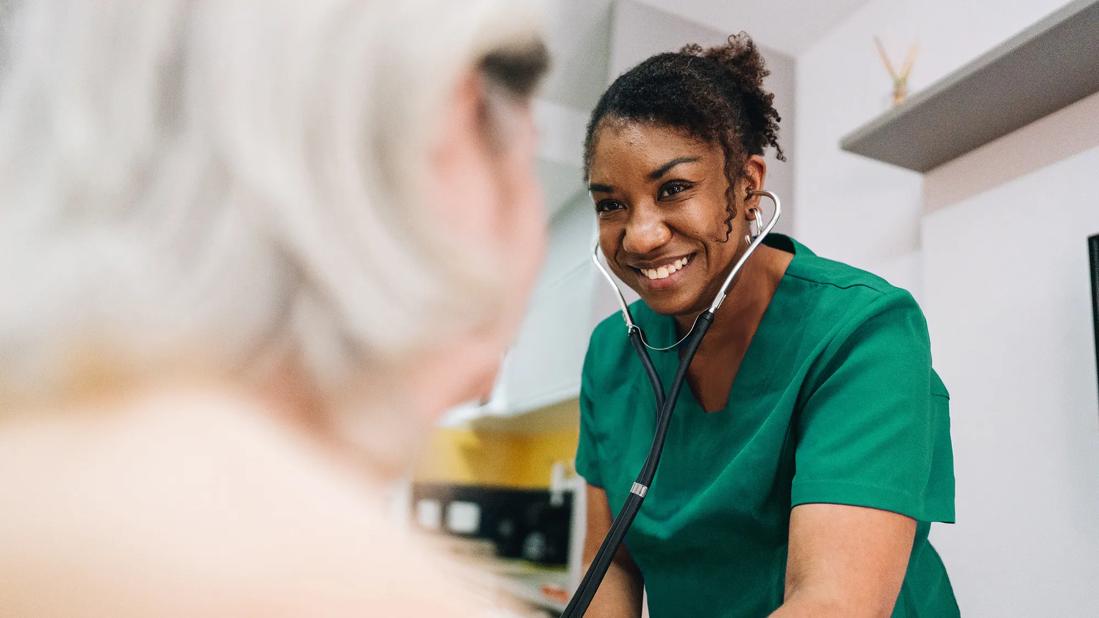Changes benefit students and preceptors

For medical school students, placement at a healthcare organization to earn clinical hours is almost a guarantee. The same can’t be said for those studying to be advanced practice registered nurses (APRNs).
Advertisement
Cleveland Clinic is a non-profit academic medical center. Advertising on our site helps support our mission. We do not endorse non-Cleveland Clinic products or services. Policy
“There is no direct line for advanced practice registered nursing students to come to an organization and get their clinical hours,” says Jennifer Docherty, program coordinator, APRN, nursing practice support and assistant to Cleveland Clinic’s Executive Chief Nursing Officer. “It’s more like a first come, first serve scenario.”
And with the growing number of people pursuing APRN careers, students have a harder time securing clinical hours and preceptors find it harder to offer them. In 2015, between 10,000 and 12,000 APRN students were graduating nationally, according to the American Association of Nurse Practitioners (AANP). By 2017, that more than doubled to 26,000, reports AANP. Depending on the area of study, each student is required to have between 500 and 1,000 hours in clinical hours to graduate.
Three years ago, the leaders of Cleveland Clinic’s APRN Student Precepting Program made a significant change to the precepting acceptance process. At the time, the health system had 62 affiliation agreements with nursing schools that covered 10 APRN tracks. Students often contacted APRN preceptors directly to request hours.
“Our preceptors were getting an overwhelming number of calls and unscheduled visits from students,” says Docherty. “It was frustrating for them, and many had to turn students away. We began requiring a precepting application. Initially, we received pushback from academic programs. But it was the only fair way to better accommodate the high number of precepting requests we were getting and support our preceptors at the same time.”
Advertisement
To precept at Cleveland Clinic, the new process meant that APRN students had to complete an online application and student profile. The profile included their resume, goals for the rotation, preferred departments, specialties and locations. Cleveland Clinic APRNs interested in serving as preceptors also created a profile, which included their clinical specialty, work location and the types of students they were interested in precepting. Like an online dating site, the application software provided data for the clinical team to match students with the right preceptors and locations.
It also provided program leaders a comprehensive database of active preceptors and students, the length of a student’s rotation, and outlined student-preceptor pairings. And it relieved preceptors of tasks around onboarding students, such as securing them access to Cleveland Clinic facilities and technologies.
“We wanted the APRN Student Precepting Program to be more organized and structured, but we also wanted to make the experience more valuable for students and preceptors,” says Shanna Botos, DNP, APRN-CNP. “A lot of what I learned as an APRN student was during my clinical rotation. The hands-on training that occurs during clinical hours is a necessary part of an APRN student’s education.”
The first semester that the new application process was introduced, 500 students applied.
“When we started this, we were worried it might turn people away,” Docherty admits. “It didn’t. Semester after semester, we’ve had the same average number of applications.”
Advertisement
Cleveland Clinic academic partners also have since embraced the process. Schools that use the application software can receive notifications when students apply for clinical hours at Cleveland Clinic. Academic advisors can log in, view a student’s application and guide students to the type of hours they need.
“One of the coolest things to evolve out of this process was unveiling incentives and barriers to precepting,” Dr. Botos says. “We’ve uncovered a lot through our APRN Preceptor Council, which initially developed because of my doctoral project.”
Dr. Botos and Docherty chair the 30-member council, whose work is dedicated to leading change. The council has resulted in improvements relating to the quality and quantity of Cleveland Clinic preceptors. It has established a formal evaluation for the end of each clinical rotation and has enhanced data collection and analysis.
“Before, if students weren’t performing well, we didn’t really know,” Dr. Botos says. “Now, thanks to the council, we have feedback forums where preceptors provide ongoing updates and printable time logs. Additionally, at the end of each rotation, they complete student performance evaluations.”
Students who receive exceptional evaluations are directed to Cleveland Clinic’s recruitment team for potential job hiring opportunities. Students in their final rotation also complete a survey that includes a question about interest in Cleveland Clinic jobs. If they select yes, they are connected to a customized recruitment page and placed in a job candidate pipeline.
Advertisement
“We’ve made it our mission to place as many students as possible per rotation,” Docherty says. “That includes Cleveland Clinic employees as well as non-employees.”
At the end of all rotations, students complete a 10-question survey, which includes questions about workload, preceptor strengths/weaknesses, an adequate learning environment and meeting goals and objectives. The application software allows program leaders to track data such as the number of students applying from each partner school.
“We now have metrics we can take to executive leadership to show what our preceptors are doing and how students are progressing,” Dr. Botos says. “Before this process, we had no real data to speak to the incredible work that the preceptors were doing or the hiring that resulted.”
Docherty agrees. “It has been so worth it,” she says. “And we are still growing with the process and learning from the data.”
Today, Cleveland Clinic has 2,200 APRNs across the system and nearly half serve as preceptors to APRN students. Cleveland Clinic preceptors volunteered 84,443 hours to precept students in 2021. Preceptors are recognized on their annual performance reviews for volunteering their time. They are also able to turn on or off their profiles depending on their precepting capacity.
“By doing this, we’ve helped more students than not, and nationally we are making a big difference by getting APRN students the clinical hours they need,” Dr. Botos says. “Our preceptors are amazing! We can’t thank them enough for all that they do for the students as well as all they’ve done to evolve this process into what it has become.”
Advertisement
Cleveland Clinic accepts APRN student precepting applications three times a year, beginning July 1, December 1, and March 1. Students have a two-month window to apply once the application period opens. Watch a video about the program below.
Advertisement

New center offers programming for kindergarteners to adults to help build a nursing pipeline

How to move from working side-by-side with nursing colleagues to leading a team

Caregivers build their professional portfolios one step at a time

Nursing center provides unique opportunities for career exploration

Nurse associate externship attracts more participants with flexible scheduling, more hands-on opportunities

Determination, preparation and education opened up opportunities in one nurse’s chosen specialty

A 20-year nursing veteran shares his experiences from caring for patients in a variety of specialties

Cleveland Clinic’s Executive CNO reflects on the image of nursing, aspirations for nurse leaders and more